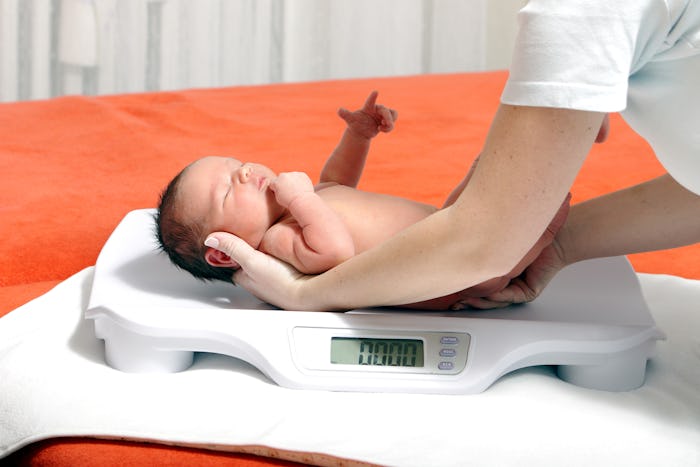One of the first questions people will ask you after you’ve given birth is how much the baby weighs. And sometimes it seems like the higher the number, the better, since people often associate a newborn with lots of rolls and folds with being healthy. Although delivering a large baby can give you some serious bragging rights, it can also be a serious issue, too. You might be wondering: What is fetal macrosomia? It’s something that all moms-to-be should be aware of during their pregnancies.
In short, fetal macrosomia is a medical term that is used to describe a baby who is larger than average at time of birth. “It is defined as a birth weight that is greater than eight pounds, 13 ounces (4,000 grams) regardless of gestational age,” Dr. Cherilyn Cecchini, a board certified pediatrician at Your Doctors Online, tells Romper. “Large for gestational age is defined as weight, length or head circumference that is greater than the 90th percentile at birth.”
Fetal macrosomia affects about 9% of all newborns, the Mayo Clinic reported, and it can happen for a wide variety of reasons. “Fetal macrosomia is sometimes caused by genetic conditions that increase the rate or speed of growth of your baby during pregnancy,” says Dr. Cecchini. “If other risk factors aren't present, your physician may recommend specific genetic tests to help identify a potential cause.” It can also be brought on by maternal diabetes, too. “Several risk factors for fetal macrosomia have been identified, and the strongest one is maternal diabetes,” says Dr. Cecchini. Other potential causes include maternal obesity, being overdue, or if you’ve been pregnant before, since the risk for fetal macrosomia increases with each pregnancy, What To Expect reported.
Unfortunately, there are risks to fetal macrosomia. “Fetal macrosomia can be associated with several different complications, including prolonged labor, increased risk of infection, postpartum hemorrhage, the need for a caesarean section at time of delivery, and increased perineal tears,” says Dr. Cecchini. And babies with fetal macrosmia are at an increased risk of meconium aspiration, clavicular fracture, nerve injury of the upper arm and shoulder dystocia, cited the American College of Obstetrics and Gynecology.
Now, there are ways to detect fetal macrosomia during pregnancy. If your fundal height (the distance from the top of your uterus to your pubic bone) is large, it might be an indicator of the condition. Another possible predictor is if you have too much amniotic fluid, since the amount of fluid reflects your baby’s urine output (read: bigger baby in utero = more pee pee production).
Although fetal macrosomia might be unavoidable in some pregnancies, staying on top of your maternal health during your nine months and speaking with your medical provider can ensure a safe delivery for both you and your baby. So while there might be nothing like a deliciously big baby at birth, in the case of fetal macrosomia, bigger isn't always better.
Experts:
Dr. Cherilyn Cecchini, board certified pediatrician at Your Doctors Online
